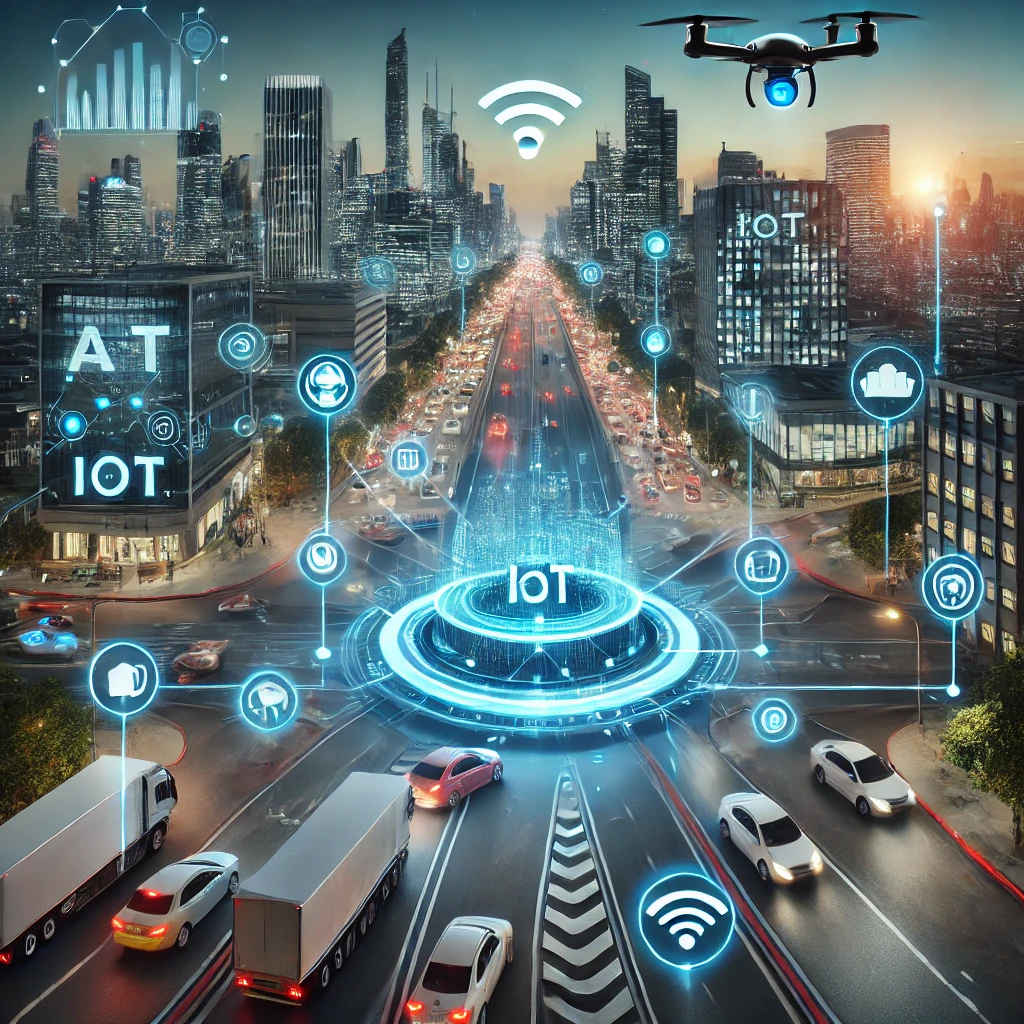Introduction
In today’s rapidly urbanizing world, traffic congestion is one of the most pressing challenges. Traditional traffic management methods often fail to cope with the increasing number of vehicles on roads, leading to inefficiencies, delays, and increased pollution. This has given rise to Smart Traffic Management Systems (STMS), which leverage cutting-edge technologies such as artificial intelligence (AI), the Internet of Things (IoT), and big data analytics to optimize traffic flow and improve urban mobility.
This article explores the concept of smart traffic management systems, their components, benefits, challenges, and future prospects in transforming urban transportation.
Understanding Smart Traffic Management Systems
What is a Smart Traffic Management System?
A Smart Traffic Management System (STMS) is an integrated network of technology-driven solutions aimed at monitoring, controlling, and optimizing traffic flow in real time. These systems use a combination of IoT sensors, AI-powered analytics, and automated control mechanisms to enhance road safety, minimize congestion, and improve overall transportation efficiency.
Key Components of Smart Traffic Management Systems
- Intelligent Traffic Lights: Smart traffic signals adjust in real time based on traffic conditions, reducing unnecessary stops and improving traffic flow.
- IoT Sensors & Cameras: Sensors embedded in roads and traffic cameras collect real-time data on vehicle movement, congestion, and accidents.
- AI-Powered Analytics: AI algorithms analyze traffic data to predict congestion patterns and suggest optimal routes.
- Smart Parking Systems: IoT-based parking solutions guide drivers to available parking spots, reducing the time spent searching for parking.
- Vehicle-to-Infrastructure Communication (V2I): Cars communicate with traffic signals, road sensors, and other infrastructure to improve traffic coordination.
- Autonomous Traffic Monitoring Drones: Some cities use drones to monitor traffic conditions and detect bottlenecks or accidents.
- Traffic Management Centers (TMCs): Centralized control hubs oversee city-wide traffic operations and implement dynamic traffic control measures.
How Smart Traffic Management Systems Work
STMS operate by collecting real-time data, analyzing traffic patterns, and dynamically adjusting traffic control measures. The workflow of a typical system includes:
- Data Collection: IoT sensors, cameras, and GPS systems gather data on vehicle movements, congestion levels, and environmental conditions.
- Data Processing: AI and machine learning algorithms analyze traffic data to detect trends, predict congestion, and suggest interventions.
- Decision Making: Based on data insights, traffic lights adjust their timing, rerouting suggestions are provided, and emergency response teams are notified in case of accidents.
- User Integration: Commuters receive live updates via mobile apps, GPS systems, or digital road signs to help them choose the fastest routes.
- Continuous Optimization: The system continuously refines its algorithms based on real-time and historical data for improved efficiency over time.
Benefits of Smart Traffic Management Systems
1. Reduced Traffic Congestion
STMS optimize traffic light patterns, implement dynamic lane management, and suggest alternative routes to ease congestion.
2. Improved Road Safety
With AI-powered predictive analytics, STMS can identify high-risk areas, adjust speed limits, and alert drivers to hazardous conditions, reducing accidents.
3. Lower Carbon Emissions
Efficient traffic flow minimizes fuel wastage caused by idling and frequent braking, leading to reduced greenhouse gas emissions and improved air quality.
4. Enhanced Emergency Response
Smart systems can prioritize emergency vehicles by adjusting traffic signals, ensuring faster response times for ambulances, fire trucks, and police vehicles.
5. Better Public Transportation Efficiency
STMS can synchronize traffic lights with buses and trams, giving priority to public transport and improving reliability.
6. Real-Time Traffic Updates for Commuters
Navigation apps integrated with smart traffic systems provide real-time route suggestions, helping drivers avoid congestion and save time.
7. Economic Benefits
Reduced congestion leads to lower transportation costs for businesses, improved productivity, and enhanced economic growth in urban areas.
Challenges of Implementing Smart Traffic Management Systems
1. High Implementation Costs
The installation of IoT sensors, AI-based software, and communication networks requires significant financial investment.
2. Data Privacy & Security Risks
Smart systems rely on extensive data collection, which raises concerns about privacy and potential cyber threats.
3. Infrastructure Limitations
Older cities with outdated infrastructure may require major upgrades to support STMS, posing logistical challenges.
4. Interoperability Issues
Different cities and countries use varied technologies, making it difficult to integrate and standardize smart traffic solutions globally.
5. Public Acceptance & Compliance
The success of STMS depends on user cooperation. Drivers may resist change or be unwilling to adopt new technologies.
6. Maintenance & Scalability
Continuous maintenance is needed to keep sensors, cameras, and software operational. Expanding systems to growing urban populations is also a challenge.
Real-World Applications of Smart Traffic Management Systems
1. Smart Traffic Lights in Los Angeles, USA
Los Angeles has implemented an Automated Traffic Surveillance and Control (ATSAC) system that synchronizes over 4,500 traffic signals, reducing travel times and improving congestion management.
2. AI-Powered Traffic Flow in Singapore
Singapore uses AI-based traffic control systems to manage vehicle flow, optimize public transport schedules, and reduce congestion hotspots.
3. Intelligent Traffic Systems in London, UK
London’s smart traffic network integrates data from CCTV cameras, sensors, and public transport to dynamically adjust road usage and improve mobility.
4. Smart Road Pricing in Stockholm, Sweden
Stockholm has implemented a congestion pricing model where smart sensors charge vehicles based on road usage, encouraging alternative transport methods.
5. Smart Parking Solutions in Barcelona, Spain
Barcelona uses IoT-based parking systems that guide drivers to available spaces, significantly reducing traffic caused by parking searches.
Future Trends in Smart Traffic Management
1. Integration with Autonomous Vehicles
Self-driving cars will communicate directly with traffic systems, reducing human errors and improving road efficiency.
2. 5G-Enabled Smart Cities
With the rise of 5G networks, real-time data transmission will enhance the efficiency of traffic management systems.
3. Blockchain for Traffic Data Security
Blockchain technology can enhance the security of traffic data, preventing hacking and ensuring transparency.
4. AI-Driven Predictive Traffic Control
Future STMS will use AI to predict and prevent congestion before it occurs, making cities smarter and more responsive.
5. Eco-Friendly Traffic Management
Future traffic systems will incorporate green initiatives, such as electric vehicle (EV) priority lanes and solar-powered traffic signals.
Conclusion
Smart Traffic Management Systems are transforming urban mobility by optimizing traffic flow, reducing congestion, and improving safety. Despite challenges such as high costs and data security concerns, the benefits far outweigh the drawbacks. As cities continue to expand, investing in smart traffic solutions will be essential for ensuring sustainable and efficient transportation systems.
By integrating advanced technologies like AI, IoT, and 5G, the future of smart traffic management promises a seamless, efficient, and eco-friendly transportation network, making urban commuting faster, safer, and more sustainable.




